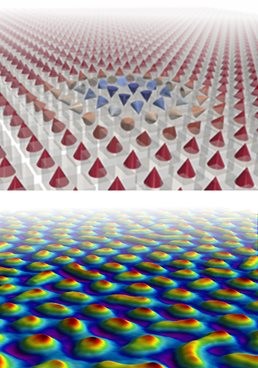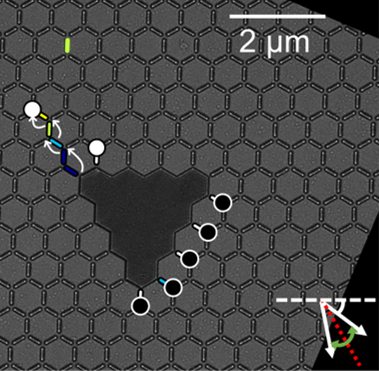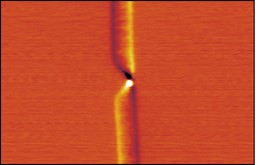Spin-based nanodevices offer a number of advantages, combining computation with logic and non-volatile magnetic memory. Topologically protected spin structures can be used as information carriers in data storage, processing and transmission devices for highly energy-efficient next-generation computing. Such devices representing artificial synapses will be faster and more energy efficient than current charge-based electronics. This exciting area represents our long-term vision.
 Smaller, faster, and more efficient electronic devices are a vital part of the UK’s economic growth and industrial innovation. This is directly evidenced by the recent publication of the Royce road mapping exercise for low loss electronics.
Smaller, faster, and more efficient electronic devices are a vital part of the UK’s economic growth and industrial innovation. This is directly evidenced by the recent publication of the Royce road mapping exercise for low loss electronics.
Spintronics, involves the utilisation of the intrinsic spin of electrons to process information in a way that is analogous to charge in traditional electronics. The benefits of this approach will lead to more efficient, low energy consumption devices that are faster than their charge-based counterparts.
One of the approaches on the way to implementation of green ICT is magnetic skyrmions. We are currently investigating how skyrmions can be utilised as next-gen information carriers in addition to developing the metrological framework associated with measurements of skyrmions. Skyrmions are of interest due to their ability to be manipulated and moved with spin polarised electrical currents at very low current densities.
Additionally, their inherent stability which arises due to the unique topology, affords them particle like properties and nanoscale size. This makes them perfect candidates for novel logic/storage architectures for low loss electronic devices. It is also why they have received attention for their applicability to be incorporated into low loss neuromorphic inspired devices with skyrmion based synapse and neuron devices demonstrated.
TOPS a collaborative project with Euramet aims to progress topologically-protected spin structures (TSS) towards standardisation and support Europe’s continuing expertise and competitiveness in electronic device manufacturing. The project will develop and validate measurement tools and techniques for describing TSS, helping to identify key parameters that determine the formation, size and stability.
 Probabilistic devices built from nanomagnets that are inspired by neural networks offer an energy efficient alternative to compute traditionally complex problems, similar to quantum computers. They have the bonus that they can operate at room temperature, are non-volatile and are easier to fabricate than q-bits. Arrays of nanomagnets have been demonstrated to perform tasks that are both time and energy intensive on traditional computers, including speech recognition, integer factorisation, and predictive modelling.
Probabilistic devices built from nanomagnets that are inspired by neural networks offer an energy efficient alternative to compute traditionally complex problems, similar to quantum computers. They have the bonus that they can operate at room temperature, are non-volatile and are easier to fabricate than q-bits. Arrays of nanomagnets have been demonstrated to perform tasks that are both time and energy intensive on traditional computers, including speech recognition, integer factorisation, and predictive modelling.
However, there are still challenges. One bottleneck for miniaturising spintronics devices is that temperature plays an increasingly important role on the collective response on the nanoscale. Therefore, it is important to underpin developments in this field with metrological advancements in order to better understand the many effects that occur between nanomagnetic elements in response to external stimuli.
Artificial spin ice (ASI) are lithographically designed arrays of magnetic nanowires or nanoelements that are arranged such that they exhibit degenerate energy states through geometric frustration. As the lattices are lithographically defined, it is possible to tune the interactions within the arrays to probe a plethora of frustration physics including phase transitions, collective dynamics, and formation/manipulation of emergent monopoles.
Mobile magnetic monopoles in ASI are of interest for high-frequency dynamics and low energy reconfigurable memory. The potential to control monopole avalanche dynamics provides a first step towards using artificial spin systems as platforms for reprogrammable magnonic resonators and crystals. The flexibility in ASI design may allow the creation of artificial spin system geometries that can channel high-frequency excitations along a particular pathway as chosen by the trigger of a specific avalanche. We have focused our research efforts on modified lattice designs to create hybrid systems that tune the lattice energies for application in novel computation. We evaluate their specific behaviours using a combination of bespoke magnetic imaging techniques, electrical measurements, and measurements of high-frequency magnetisation dynamics.
 Individual DW manipulation has the potential to enable a wide range of new devices. From logic circuits that use DWs for information transfer, requiring only a fraction of the energy current computers use; to chips to manipulate individual MNPs and perform biological analysis such drug testing or cell manipulation. We perform combined to develop DW-based technologies.
Individual DW manipulation has the potential to enable a wide range of new devices. From logic circuits that use DWs for information transfer, requiring only a fraction of the energy current computers use; to chips to manipulate individual MNPs and perform biological analysis such drug testing or cell manipulation. We perform combined to develop DW-based technologies.
Our electromagnetic laboratory enables measurement of electrical effects associated with changes in magnetization (such as magnetoresistance, anomalous Hall effect, anomalous Nernst effect), individual DW detection, and electrical manipulation of DW using current pulses. The MFM studies, which can be customised to allow simultaneous electrical measurements, has enabled imaging of DW dynamics including DW movement through electrically driven spin torque.
Our research and measurement solutions support innovation and product development. We work with companies to deliver business advantage and commercial success.
Contact our Customer Services team on +44 20 8943 7070